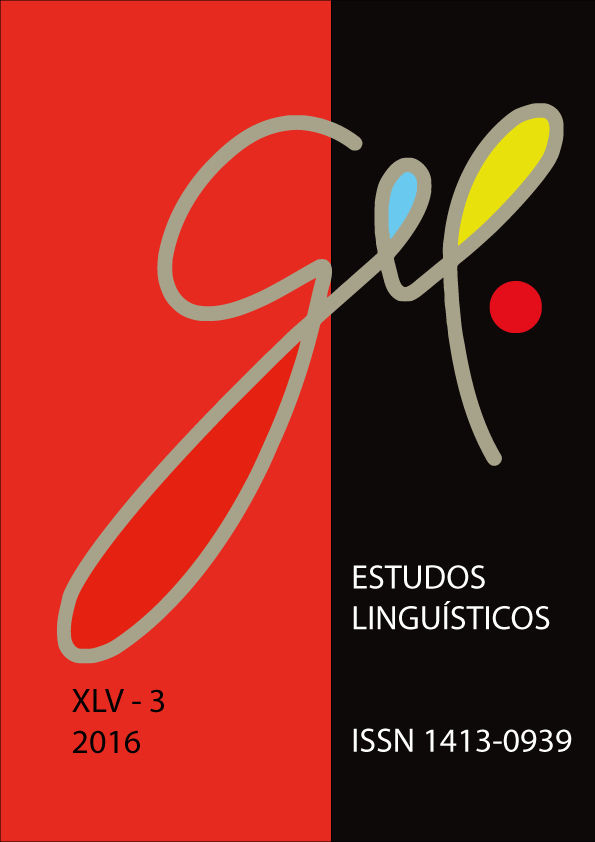Guttural Voice and Death Metal: Stereotypical Regularities in the Constitution of Possible Ethé
DOI:
https://doi.org/10.21165/el.v45i3.661Keywords:
Discourse analysis, stereotype, ethos, death metal.Abstract
This paper analyses some meaning effects engendered by a specific discursive constitution of songs belonging to the musical genre known as death metal, with respect to the voice quality used by vocalists, for instance. The obscure, animalistic and distorted feature of such voice, called guttural, constitutes one of the language elements that legitimize the effects of meaning to be produced in the circulation of the songs, when this element is combined with other materialities (lyrics, album covers, and performances). Based on Dominique Maingueneau’s theoretical proposals, this research assumes the hypothesis that the emergence of the mode of enunciating death metal is not a mere “stylistic choice”, but a result of how the discursive practice established in this musical genre, which recurs to stereotypes crystallized throughout history, manages the ethé of enunciators in songs.
Downloads
References
AMOSSY, R. O ethos na intersecção das disciplinas: retórica, pragmática, sociologia dos campos. In: ______ (org.). Imagens de si no discurso. 2. ed. São Paulo: Contexto, 2013. p. 119-144.
BOYER, H. Stéréotype, emblème, mythe. Mots, Lyon, v.1, n.88, 2008. Disponível em: <http://mots.revues. org/14433>. Acesso em: 20 abr. 2015.
CÁCERES, P. A. C. As representações do Diabo no imaginário dos fiéis da Igreja Universal do Reino de Deus. 2006. 143 f. Dissertação (Mestrado em Ciências da Religião) – Departamento de Filosofia e Teologia, Universidade Católica de Goiás, Goiânia.
CHARAUDEAU, P. Les stéréotypes, c’est bien. Les imaginaires, c’est mieux. In : BOYER, H. (dir.). Stéréotypage, stéréotypes: fonctionnements ordinaires et mises en scène. Paris: L’ Harmattan, 2007. p. 23-28.
DUCROT, O. O dizer e o dito. Campinas: Pontes, 1987. 222 p.
DUNN, S. Lands of fire and ice: an exploration of death metal scenes. In: Art, culture and ideas. Toronto, n.29, p. 106-125, 2004.
HARRIS, K. Extreme Metal: music and culture on the edge. New York: Berg, 2007. 224 p.
LABAN, R. Musica Rock y Satanismo. Cidade do México: Arco Iris, 1989. 160 p.
MAINGUENEAU, D. A propósito do ethos. In: MOTTA, A. R.; SALGADO, L. (orgs.). Ethos discursivo. 2. ed. São Paulo: Contexto, 2015. p. 11-32.
MAINGUENEAU, D. Discurso literário. Tradução de Adail Sobral. São Paulo: Contexto, 2006. 329 p.
MAINGUENEAU, D. Ethos, cenografia e incorporação. In: AMOSSY, R (org.). Imagens de si no discurso. 2. ed. São Paulo: Contexto, 2013. p. 69-92.
MAINGUENEAU, D. Novas tendências em Análise do Discurso. 3. ed. Campinas: Pontes, 1997. 197 p.
NOGUEIRA, C. R. O Diabo no imaginário cristão. 2. ed. Bauru: EDUSC, 2002. 126 p.
O’GRADY, J. Satã: O príncipe das trevas. Tradução de José Antonio Ceschin. São Paulo: Mercuryo, 1991. 189 p.
OLIVA, A. S. A história do diabo no Brasil. São Paulo: Fonte Editorial, 2007. 288 p.
PEREIRA, M. E. Psicologia Social dos Estereótipos. São Paulo: E.P.U., 2002. 202 p.
SARAMAGO, J. O evangelho segundo Jesus Cristo. São Paulo: Companhia das Letras, 1991. 448 p.



